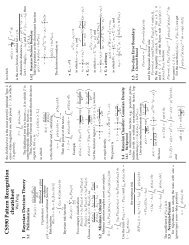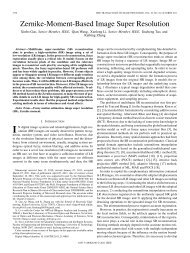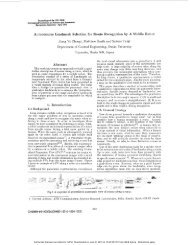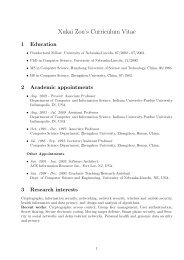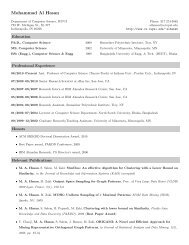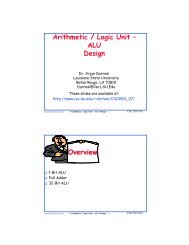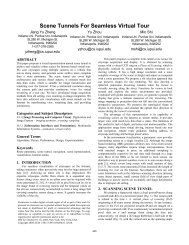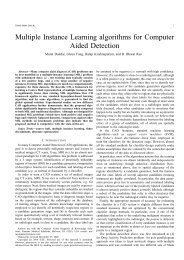Towards Fully Automatic Exection Monitoring, in ... - UniFrame
Towards Fully Automatic Exection Monitoring, in ... - UniFrame
Towards Fully Automatic Exection Monitoring, in ... - UniFrame
Create successful ePaper yourself
Turn your PDF publications into a flip-book with our unique Google optimized e-Paper software.
<strong>Towards</strong> <strong>Fully</strong> <strong>Automatic</strong> Execution <strong>Monitor<strong>in</strong>g</strong><br />
Cl<strong>in</strong>ton Jeffery, Mikhail Auguston, Scott Underwood<br />
Department of Computer Science, New Mexico State University<br />
{jeffery, mikau, sunderwo}@cs.nmsu.edu<br />
Abstract. UFO is a new application framework <strong>in</strong> which programs written <strong>in</strong><br />
FORMAN, a declarative assertion language, are compiled <strong>in</strong>to execution monitors that<br />
run on a virtual mach<strong>in</strong>e with extensive monitor<strong>in</strong>g capabilities provided by the Alamo<br />
monitor architecture. FORMAN provides an event trace model <strong>in</strong> which precedence and<br />
<strong>in</strong>clusion relations def<strong>in</strong>e a DAG structure that abstracts execution behavior. Compil<strong>in</strong>g<br />
FORMAN assertions <strong>in</strong>to hybrid run-time/post-mortem monitors allows substantial<br />
speed and size improvements over post-mortem analyzers. The UFO compiler generates<br />
code that computes the m<strong>in</strong>imal projection of the DAG necessary for a given set of<br />
assertions. UFO enables fully automatic execution monitor<strong>in</strong>g of real programs. The<br />
approach is non-<strong>in</strong>trusive with respect to program source code and provides a high level<br />
of abstraction for monitor<strong>in</strong>g and debugg<strong>in</strong>g activities. The ability to compile suites of<br />
debugg<strong>in</strong>g rules <strong>in</strong>to efficient monitors, and apply them generically to different<br />
programs, enables long-overdue breakthroughs <strong>in</strong> program debugg<strong>in</strong>g.<br />
1. Motivation<br />
Debugg<strong>in</strong>g is one of the most challeng<strong>in</strong>g and least developed areas of software<br />
eng<strong>in</strong>eer<strong>in</strong>g. A special issue of Communications of the ACM characterized the<br />
current state of debugg<strong>in</strong>g tools as a "Debugg<strong>in</strong>g scandal" [1]. Accord<strong>in</strong>g to the<br />
classic "Brook’s rule" [2] more than 50% of all time and effort <strong>in</strong> a software project is<br />
spent <strong>in</strong> test<strong>in</strong>g and debugg<strong>in</strong>g activities. Typical activities <strong>in</strong>clude detection and<br />
removal of errors, profil<strong>in</strong>g, and performance tun<strong>in</strong>g.<br />
Debugg<strong>in</strong>g activities <strong>in</strong>clude queries regard<strong>in</strong>g many aspects of target program<br />
behavior: sequences of steps performed, histories of variable values, function call<br />
hierarchies, check<strong>in</strong>g of pre- and post-conditions at specific po<strong>in</strong>ts, and validat<strong>in</strong>g<br />
other assertions about program execution. Performance test<strong>in</strong>g and debugg<strong>in</strong>g<br />
<strong>in</strong>volves a variety of profiles and time measurements. Visualization is another<br />
common debugg<strong>in</strong>g activity that may help locate logic or performance problems.<br />
There is an urgent need for tools that automate the primary, labor-<strong>in</strong>tensive tasks<br />
of debugg<strong>in</strong>g, but progress has been slow. Debugg<strong>in</strong>g automation has its own system<br />
of ideas and doma<strong>in</strong>-specific programm<strong>in</strong>g activities. Support for these concepts and<br />
activities is essential <strong>in</strong> order to move debugg<strong>in</strong>g automation forward.<br />
We are build<strong>in</strong>g automatic debugg<strong>in</strong>g tools based on precise program execution<br />
behavior models that enable us to employ a systematic approach. Our program<br />
behavior models are based on events and event traces [3][4][5]. Debugg<strong>in</strong>g<br />
automation refers to a computation over an event trace. Program execution monitors<br />
are programs that load and execute a target program, obta<strong>in</strong> events at run-time, and<br />
perform computations over the event trace. Computations are performed dur<strong>in</strong>g<br />
execution, post-mortem, or <strong>in</strong> any mixture of both times.
Any detectable action performed dur<strong>in</strong>g a target program's run time is an event.<br />
For <strong>in</strong>stance, expression evaluations, statement executions, and procedure calls are all<br />
examples of events. An event has a beg<strong>in</strong>n<strong>in</strong>g, an end, and some duration; it occupies<br />
a time <strong>in</strong>terval dur<strong>in</strong>g program execution. This leads to the <strong>in</strong>troduction of two basic<br />
b<strong>in</strong>ary relations on events: partial order<strong>in</strong>g and <strong>in</strong>clusion. Those relations are<br />
determ<strong>in</strong>ed by target language syntax and semantics, e.g. two statement execution<br />
events may be ordered, or an expression evaluation event may occur <strong>in</strong>side a<br />
statement execution event. The set of events produced at run time, together with<br />
order<strong>in</strong>g and <strong>in</strong>clusion relations, is called an event trace and represents a model of<br />
program behavior. An event trace forms an acyclic directed graph (DAG) with two<br />
types of edges correspond<strong>in</strong>g to the basic relations.<br />
Our previous work <strong>in</strong>cluded the FORMAN assertion language [3] and the Alamo<br />
program execution monitor<strong>in</strong>g architecture [6]. FORMAN takes a top-down<br />
approach, <strong>in</strong>troduc<strong>in</strong>g a doma<strong>in</strong>-specific syntax for express<strong>in</strong>g bug manifestations and<br />
other behavior of <strong>in</strong>terest, while Alamo takes a more bottom-up, implementationdriven<br />
approach, provid<strong>in</strong>g runtime system support for the development of monitors<br />
<strong>in</strong> which efficiency and scalability to real programs are primary concerns. Alamo’s<br />
efficient source-level access and control over monitored programs has been <strong>in</strong>tegrated<br />
<strong>in</strong>to a production virtual mach<strong>in</strong>e; <strong>in</strong> the absence of such support, monitor<strong>in</strong>g would<br />
require extensive low-level <strong>in</strong>strumentation and control mechanisms.<br />
The language UFO (Unicon-FORMAN) <strong>in</strong>tegrates the experience accumulated <strong>in</strong><br />
these previous projects to provide a complete solution for development of an<br />
extensive suite of automatic debugg<strong>in</strong>g tools. UFO is an implementation of<br />
FORMAN for debugg<strong>in</strong>g programs written <strong>in</strong> the Unicon and Icon programm<strong>in</strong>g<br />
languages [7][8]. Previous FORMAN implementations worked on subsets of Pascal,<br />
and C languages and used post-mortem event trace process<strong>in</strong>g methods that limited<br />
their applicability. In contrast, UFO uses the Alamo monitor<strong>in</strong>g architecture that<br />
pervades the Unicon virtual mach<strong>in</strong>e to support debugg<strong>in</strong>g real programs at run time.<br />
2. Unicon and Alamo<br />
The Unicon language and the Alamo monitor<strong>in</strong>g architecture provide the underly<strong>in</strong>g<br />
research framework for the implementation of UFO. Unicon is an imperative, goaldirected,<br />
object-oriented superset of the Icon programm<strong>in</strong>g language. Unicon's syntax<br />
is similar to Pascal or Java, while its semantics are higher level, featur<strong>in</strong>g built-<strong>in</strong><br />
backtrack<strong>in</strong>g and heterogeneous data structures and str<strong>in</strong>g scann<strong>in</strong>g facilities. Icon has<br />
<strong>in</strong>fluenced many script<strong>in</strong>g languages such as Python. Unicon is Icon’s direct<br />
descendant, derived from Icon's implementation. It runs regular Icon programs and<br />
extends Icon's reach with object-orientation and packages, as well as a much richer<br />
system <strong>in</strong>terface with high level graphics, network<strong>in</strong>g, and database facilities.<br />
The reference implementation of Unicon is a virtual mach<strong>in</strong>e. Virtual mach<strong>in</strong>es<br />
(VM) are attractive to language implementers, enhanc<strong>in</strong>g portability and allow<strong>in</strong>g<br />
simpler implementation of very high level language features such as backtrack<strong>in</strong>g.<br />
VMs are also ideal for develop<strong>in</strong>g debugg<strong>in</strong>g tools. VMs provide an appropriate<br />
level of abstraction for develop<strong>in</strong>g behavior models to describe program executions <strong>in</strong><br />
a processor <strong>in</strong>dependent manner, as illustrated by the JPAX tool [9]. VMs also<br />
provide easy access to program state and control flow, the <strong>in</strong>formation most needed
for debugg<strong>in</strong>g activities. <strong>Automatic</strong> <strong>in</strong>strumentation on multiple semantic levels is<br />
greatly simplified via the use of a VM. This potential was exploited <strong>in</strong> the Unicon<br />
VM by a framework that implements the Alamo monitor<strong>in</strong>g architecture. Event<br />
<strong>in</strong>strumentation and process<strong>in</strong>g support are an <strong>in</strong>tegral part of the VM.<br />
The Alamo Unicon framework is summarized <strong>in</strong> Figure 1. Execution monitors<br />
(EM) and the target program (TP) execute as (sets of) corout<strong>in</strong>es with separate stacks<br />
and heaps <strong>in</strong>side a common VM. The VM is <strong>in</strong>strumented with approximately 150<br />
k<strong>in</strong>ds of atomic events, each one report<strong>in</strong>g a pair. EMs specify<br />
categories of events by supply<strong>in</strong>g an event mask when they activate the TP by<br />
corout<strong>in</strong>e switch. The TP executes up to an event of <strong>in</strong>terest.<br />
Unicon Virtual Mach<strong>in</strong>e state access functions<br />
TP<br />
m<br />
a<br />
s<br />
k<br />
EM<br />
VM <strong>in</strong>strumentation<br />
Fig. 1. Alamo architecture with<strong>in</strong> the Unicon VM.<br />
The event mask is used by the VM for <strong>in</strong>strumentation selection and control. Event<br />
reports dur<strong>in</strong>g TP execution are corout<strong>in</strong>e context switches from the VM runtime<br />
system back to the execution monitor. In addition to the reported for the<br />
event, the EM can directly access arbitrary variable values and state <strong>in</strong>formation from<br />
the TP via state access functions. Monitors are written <strong>in</strong>dependently from the target<br />
program, and can be applied to any target program without recompil<strong>in</strong>g the monitor<br />
or target program. Monitors dynamically load target programs, and can easily query<br />
the state of arbitrary variables at each event report. Multiple monitors can monitor a<br />
program execution, under the direction of a monitor coord<strong>in</strong>ator.<br />
Alamo's goal was to reduce the difficulty of writ<strong>in</strong>g execution monitors to be just<br />
as easy as writ<strong>in</strong>g other types of application programs. UFO moves beyond Alamo to<br />
efficiently support FORMAN's more ambitious goal of reduc<strong>in</strong>g the difficulty of<br />
writ<strong>in</strong>g automatic debuggers to the task of specify<strong>in</strong>g generic assertions about<br />
program behavior. UFO’s FORMAN language is described <strong>in</strong> Section 4 below, but<br />
first it is necessary to present the underly<strong>in</strong>g behavior model.<br />
3. An Event Grammar for Unicon<br />
Event grammars provide a model of program run time behavior. Monitors do not have<br />
to parse events us<strong>in</strong>g this grammar, s<strong>in</strong>ce event detection is part of VM and UFO<br />
runtime system functionality. Monitors implement computations over event traces<br />
supplied by the VM. An event is an abstraction of a detectable action performed at<br />
run time and has an event type and various attributes associated with it. The follow<strong>in</strong>g<br />
description <strong>in</strong> fact provides a "lightweight" semantics of the Unicon programm<strong>in</strong>g<br />
language tailored for specification of debugg<strong>in</strong>g activities. An event corresponds to
some specific action of <strong>in</strong>terest performed dur<strong>in</strong>g program execution. Event type is an<br />
important part of the behavior model.<br />
Universal attributes are found <strong>in</strong> every event. They frequently are used to narrow<br />
assertions down to a particular doma<strong>in</strong> (function, variable, value) of <strong>in</strong>terest. Some of<br />
these attributes are much easier to obta<strong>in</strong> than others, and affect the optimizations that<br />
can be performed when generat<strong>in</strong>g monitor code; see Section 5 for details.<br />
source_text: <strong>in</strong> a canonical form<br />
l<strong>in</strong>e_num, col_num: source text locations<br />
time_at_end, time_at_beg<strong>in</strong>, duration: tim<strong>in</strong>g attributes<br />
eval_at_beg<strong>in</strong> (Unicon-expr),<br />
eval_at_end (Unicon-expr): runtime access to the program states<br />
prev_path, follow<strong>in</strong>g_path: set of events before/after this event<br />
Event types and their type-specific attributes are summarized <strong>in</strong> the table below.<br />
Event Type Description Type Specific Attributes<br />
prog_ex whole program execution<br />
expr_eval expression evaluation value, operator, type, failure_p<br />
func_call function call func_name, paramlist<br />
<strong>in</strong>put, output I/O file<br />
variable variable reference<br />
literal reference to a constant value<br />
lhp lefthand part, assignment address<br />
rhp righthand part, assignment<br />
clause then-, else-, or case branch execution<br />
test test evaluation<br />
iteration loop iteration<br />
Event types form a hierarchy, shown <strong>in</strong> Figure 2. Subtypes <strong>in</strong>herit attributes from<br />
the parent type. Expression evaluation is the central action dur<strong>in</strong>g Unicon program<br />
execution, this expla<strong>in</strong>s why the expr_eval event is on the top of the hierarchy.<br />
expr_eval<br />
clause iteration test lhp func_call rhp variable param literal<br />
<strong>in</strong>put output<br />
Fig 2. Event Type Inheritance Hierarchy<br />
The UFO event grammar for Unicon is a set of axioms describ<strong>in</strong>g the structure of<br />
event traces with respect to the two basic relations: <strong>in</strong>clusion and precedence. The<br />
grammar is one possible abstraction of Unicon semantics; other event grammars with<br />
far more (or less) detail might be used. The event grammar limits what k<strong>in</strong>ds of bugs<br />
can be detected, so some detail is useful. The grammar uses the follow<strong>in</strong>g notation:
Notation Mean<strong>in</strong>g<br />
A :: (B C) B precedes A, A <strong>in</strong>cludes B and C<br />
A* Zero or more A’s under precedence<br />
A+ One or more A’s under precedence<br />
A | B Either A or B; alternative<br />
A? A is optional<br />
{ A , B } Set; A and B have no precedence<br />
x : A Let x denote event A<br />
prog_ex:: ( expr_eval *)<br />
expr_eval:: ( ( expr_eval ) | unary op<br />
( expr_eval expr_eval ) | b<strong>in</strong>ary op<br />
( expr_eval+ ) |<br />
( test clause ) | conditional / case expressions<br />
( iteration * ) | loops<br />
( { lhp, rhp} ) assignment<br />
lhp and rhp are not ordered, beg<strong>in</strong>n<strong>in</strong>g of<br />
lhp precedes rhp, and end of lhp follows rhp<br />
)<br />
iteration:: ( test expr_eval*) | ( expr_eval* test ) | ( expr_eval * )<br />
Execution of a Unicon program produces a set of events (an event trace) organized<br />
by precedence and <strong>in</strong>clusion <strong>in</strong>to a DAG. The structure of the event trace (event<br />
types, precedence and <strong>in</strong>clusion of events) is constra<strong>in</strong>ed by the event grammar<br />
axioms above. The event trace models Unicon program behavior and provides a basis<br />
to def<strong>in</strong>e different k<strong>in</strong>ds of debugg<strong>in</strong>g activities (assertion check<strong>in</strong>g, debugg<strong>in</strong>g<br />
queries, profiles, debugg<strong>in</strong>g rules, behavior visualization) as appropriate computations<br />
over the event traces.<br />
4. FORMAN<br />
Alamo allows efficient monitors to be constructed <strong>in</strong> Unicon, but us<strong>in</strong>g a specialpurpose<br />
language such as FORMAN, with the rich behavior model described <strong>in</strong> the<br />
preced<strong>in</strong>g section, has compell<strong>in</strong>g advantages. On a basic level, for example, it is<br />
convenient to refer to target program variables directly <strong>in</strong>stead of through a library<br />
call. For example, <strong>in</strong> FORMAN we may refer to target program variable x, while <strong>in</strong><br />
the Unicon monitor it is referenced as variable("x", &eventsource). UFO rules are<br />
up to an order of magnitude smaller (<strong>in</strong> terms of l<strong>in</strong>es of source code) than the<br />
equivalent imperative monitors written <strong>in</strong> Unicon, depend<strong>in</strong>g on the type of<br />
quantifiers and aggregate operations used <strong>in</strong> the FORMAN rule.<br />
More important than such conveniences are FORMAN's control structures that<br />
directly support dynamic analysis. FORMAN supports computations over event traces<br />
centered around event patterns and aggregate operations over events. The simplest<br />
event pattern consists of a s<strong>in</strong>gle event type and matches successfully an event of this<br />
type or an event of a subtype of this type. Event patterns may <strong>in</strong>clude event attributes
and other event patterns to specify the context of an event under consideration. For<br />
example, the event pattern<br />
E: expr_eval & E.operator == ":="<br />
matches an event of assignment. Temporary variable E provides an access to the<br />
events under consideration with<strong>in</strong> the pattern.<br />
The follow<strong>in</strong>g example demonstrates the use of an aggregate operation.<br />
CARD[A: func_call & A.func_name == "read" FROM prog_ex]<br />
yields a number of events satisfy<strong>in</strong>g the given event pattern, collected from the whole<br />
execution history. Expression […] is a list constructor and CARD is an abbreviation<br />
for a reduction of '+' operation over the more general list constructor:<br />
+/[A:func_call & A.func_name=="read" FROM prog_ex APPLY 1]<br />
Quantifiers are <strong>in</strong>troduced as abbreviations for reductions of Boolean operations<br />
OR and AND. For <strong>in</strong>stance,<br />
FOREACH Pattern FROM event_set Boolean_expr<br />
is an abbreviation for<br />
AND/[Pattern FROM event_set APPLY Boolean_expr ]<br />
Debugg<strong>in</strong>g rules <strong>in</strong> FORMAN usually have the form:<br />
Quantified_expression<br />
WHEN SUCCEEDS SAY-clauses<br />
WHEN FAILS SAY-clauses<br />
The Quantified_expression is optional and defaults to TRUE. The execution of<br />
FORMAN programs relies on the Unicon monitors embedded <strong>in</strong> a VM environment.<br />
Section 5 below describes the architecture of the UFO compiler and runtime system,<br />
which translates FORMAN to Unicon VM monitor code.<br />
The follow<strong>in</strong>g examples illustrate additional features of FORMAN as needed.<br />
Application-Specific Analyses<br />
This section presents formalizations of typical debugg<strong>in</strong>g rules. UFO supports and<br />
improves upon the most common application-specific debugg<strong>in</strong>g techniques. For<br />
example, UFO supports traditional precondition check<strong>in</strong>g, or pr<strong>in</strong>t statement<br />
<strong>in</strong>sertion, without any modification of the target program source code. This is<br />
especially valuable when the precondition check or pr<strong>in</strong>t statement is needed <strong>in</strong> not<br />
just one location, but <strong>in</strong>stead <strong>in</strong> many locations scattered throughout the code.<br />
Example #1: Trac<strong>in</strong>g. Probably the most common debugg<strong>in</strong>g method is to <strong>in</strong>sert<br />
output statements to generate trace files, log files, and so forth. This allows for<br />
subsequent human analysis, and while it has its limitations, it will rema<strong>in</strong> a common<br />
technique. It is possible to request evaluation of arbitrary Unicon expressions at the<br />
beg<strong>in</strong>n<strong>in</strong>g or at the end of events. The VM evaluates these expressions at the <strong>in</strong>dicated<br />
time moments, allow<strong>in</strong>g dynamic <strong>in</strong>strumentation of the Unicon program, whether to<br />
pr<strong>in</strong>t some values, or to call a visualization library subrout<strong>in</strong>e.
FOREACH A: func_call & A.func_name == “my_func” FROM prog_ex<br />
A.value_at_beg<strong>in</strong>(write(“enter<strong>in</strong>g my_func, value of X is:”,X))<br />
AND<br />
A.value_at_end(write(“leav<strong>in</strong>g my_func, value of X is:”, X))<br />
This debugg<strong>in</strong>g rule causes calls to write() to be evaluated at selected po<strong>in</strong>ts at<br />
run time, just before and after each occurrence of event A.<br />
Example #2: Profil<strong>in</strong>g. A myriad of tools are based on a premise of accumulat<strong>in</strong>g<br />
the number of times a behavior occurs, or the amount of time spent <strong>in</strong> a particular<br />
activity or section of code. The follow<strong>in</strong>g debugg<strong>in</strong>g rule illustrates such<br />
computations over the event trace.<br />
SAY("Total number of read() statements: "<br />
CARD[ r: <strong>in</strong>put & r.filename == "xx.<strong>in</strong>" FROM prog_ex ]<br />
"Elapsed time for read operations is: "<br />
SUM [ r: <strong>in</strong>put & r.filename == "xx.<strong>in</strong>" FROM prog_ex<br />
APPLY r.duration] )<br />
Example #3: Pre- and Post- Conditions. Typical use of assertions <strong>in</strong>cludes<br />
check<strong>in</strong>g pre- and post-conditions of function calls.<br />
FOREACH A:func_call & A.func_name==”sqrt” FROM prog_ex<br />
A.paramlist[1] >=0 AND<br />
abs(A.value*A.value-A.paramlist[1]) < epsilon<br />
WHEN FAILS SAY(“bad sqrt(“ A.paramlist[1] “) yields ” A.value)<br />
Generic Bug Descriptions<br />
Another <strong>in</strong>terest<strong>in</strong>g prospect is the development of a suite of generic automated<br />
debugg<strong>in</strong>g tools that can be used on any Unicon program. UFO provides a level of<br />
abstraction sufficient for specify<strong>in</strong>g typical bugs and debugg<strong>in</strong>g rules.<br />
Example #4: Detect<strong>in</strong>g Use of Un-<strong>in</strong>itialized Variables. Although read<strong>in</strong>g an un<strong>in</strong>itialized<br />
variable is permissible <strong>in</strong> Unicon, this practice often leads to errors.<br />
Therefore, <strong>in</strong> this debugg<strong>in</strong>g rule all variables with<strong>in</strong> the target program are checked<br />
to ensure that they are <strong>in</strong>itialized before they are used.<br />
FOREACH V: variable FROM prog_ex<br />
FIND D: lhp FROM V.prev_path D.source_text == V.source_text<br />
WHEN FAILS SAY( " un<strong>in</strong>itialized variable " V.source_text)<br />
Example #5: Empty Pops. Remov<strong>in</strong>g an element from an empty list is<br />
representative of many expressions that fail silently <strong>in</strong> Unicon. While this can be<br />
convenient, it can also be a source of difficult to detect logic errors. This assertion<br />
assures that items are not removed from empty lists.<br />
FOREACH a:func_call & a.func_name=="pop" &<br />
a.value_at_beg<strong>in</strong>(*a.paramlist[1]==0)<br />
SAY("Popp<strong>in</strong>g from empty list at event " a)
5. Implementation Issues<br />
The most important of implementation issues is the translation model by which<br />
FORMAN rules are compiled <strong>in</strong>to Unicon monitors. Rules are written as if they have<br />
the complete post-mortem event trace available for process<strong>in</strong>g. This generality is<br />
powerful; however the majority of assertions can be compiled <strong>in</strong>to monitors that<br />
execute entirely at runtime. Runtime monitor<strong>in</strong>g is the key to practical<br />
implementation. For assertions that require post-mortem analysis, the UFO runtime<br />
system computes a projection of the execution DAG needed to perform the analysis.<br />
The UFO translation model categorizes each rule as either "runtime", "postmortem",<br />
or "hybrid", denot<strong>in</strong>g the amount of computations that can be performed at<br />
runtime. Runtime and hybrid categories are determ<strong>in</strong>ed by constra<strong>in</strong>ts on FORMAN<br />
quantifier prefixes and result <strong>in</strong> more efficient code. Nested quantifiers and aggregate<br />
operations generally require post-mortem operation.<br />
Translation Examples<br />
Each FORMAN statement is translated <strong>in</strong>to a comb<strong>in</strong>ation of <strong>in</strong>itialization, run-time,<br />
and post-mortem code. Monitors are executed as corout<strong>in</strong>es with the Unicon target<br />
program, as expla<strong>in</strong>ed <strong>in</strong> Section 2. The follow<strong>in</strong>g examples give a flavor of the run<br />
time architecture of monitors generated from the UFO high level rules.<br />
Implementation of Example #1. A lone FOREACH quantifier is typical of many<br />
UFO debugg<strong>in</strong>g actions and allows computation to be performed entirely at runtime.<br />
The events be<strong>in</strong>g counted and values be<strong>in</strong>g accumulated determ<strong>in</strong>e an event mask <strong>in</strong><br />
the <strong>in</strong>itialization code that def<strong>in</strong>es the Alamo events that will be monitored. The<br />
monitor’s event process<strong>in</strong>g loop implements a filter based on procedure name with<strong>in</strong><br />
an if-expression. The Unicon code blocks conta<strong>in</strong><strong>in</strong>g write() expressions are <strong>in</strong>serted<br />
directly <strong>in</strong>to the event loop for the relevant events. The complete monitor is:<br />
$<strong>in</strong>clude "evdefs.icn"<br />
l<strong>in</strong>k ev<strong>in</strong>it<br />
procedure ma<strong>in</strong>(av)<br />
EvInit(av) | stop("can't monitor ", av[1])<br />
mask := E_Pcall ++ E_Pret ++ E_Pfail ++ E_Prem<br />
while EvGet(mask) do {<br />
if &eventcode == E_Pcall & &eventvalue === my_func then<br />
write(“enter<strong>in</strong>g my_func, value of X is:”, X) # BEFORE<br />
if &eventcode == (E_Pret | E_Pfail | E_Prem) &<br />
&eventvalue=== my_func then<br />
write(“leav<strong>in</strong>g my_func, value of X is:”, X) # AFTER<br />
}<br />
end<br />
Implementation of Example #2. Another typical situation <strong>in</strong>volves an aggregate<br />
operation and selection of events accord<strong>in</strong>g to a given pattern. The SAY expression is<br />
implemented by a call to write(); it must be performed post-mortem s<strong>in</strong>ce it uses<br />
parameters whose values are constructed dur<strong>in</strong>g the entire program execution. CARD<br />
denotes a counter, while SUM denotes an accumulator +/; both require a variable that<br />
is <strong>in</strong>itialized to zero. The event subtypes and constra<strong>in</strong>ts are used to generate
additional conditional code <strong>in</strong> the body of the event process<strong>in</strong>g loop. Lastly, some<br />
attributes such as r.duration require additional events and measurements besides the<br />
<strong>in</strong>itial trigger<strong>in</strong>g event. In the case of r.duration, a time measurement between the<br />
function call and its return is needed.<br />
$<strong>in</strong>clude "evdefs.icn"<br />
l<strong>in</strong>k ev<strong>in</strong>it<br />
procedure ma<strong>in</strong>(av)<br />
EvInit(av) | stop("can't monitor ", av[1])<br />
cardreads := sumreadtime := 0<br />
mask := cset(E_Fcall)<br />
while EvGet(mask) do {<br />
### count CARD of r:<strong>in</strong>put...<br />
if &eventcode == E_Fcall & &eventvalue === (read|reads) then<br />
cardreads +:= 1<br />
### add SUM of r.duration for r:<strong>in</strong>put<br />
if &eventcode == E_Fcall & &eventvalue===(read|reads) then {<br />
thiscall := &time<br />
EvGet(E_Ffail++E_Fret)<br />
sumreadtime +:= &time - thiscall<br />
}<br />
}<br />
### Translation of SAY<br />
write("Total number of read() statements: ", cardreads, "\n",<br />
"Elapsed time for read operations is: ", sumreadtime)<br />
end<br />
Basic Generation Templates<br />
The preced<strong>in</strong>g handwritten example monitors use a s<strong>in</strong>gle ma<strong>in</strong> loop that implements<br />
traditional event-driven process<strong>in</strong>g. Monitors generated by the UFO compiler reduce<br />
complex assertions to this same s<strong>in</strong>gle event loop. Keep<strong>in</strong>g event detection <strong>in</strong> a s<strong>in</strong>gle<br />
loop allows uniform process<strong>in</strong>g of multiple event types used by multiple monitors.<br />
The code generated by the UFO compiler <strong>in</strong>tegrates event detection, attribute<br />
collection, and aggregate operation accumulation <strong>in</strong> the ma<strong>in</strong> event loop.<br />
Assertions <strong>in</strong> UFO that use nested quantifiers entail two nested loops. Code<br />
generation flattens this loop structure, and postpones assertion process<strong>in</strong>g until<br />
required <strong>in</strong>formation is available. A hybrid code generation strategy performs runtime<br />
process<strong>in</strong>g whenever possible, delay<strong>in</strong>g analyses until post-mortem time when<br />
necessary. Different assertions require different degrees of trace projection storage;<br />
code responsible for trace projection collection is also arranged with<strong>in</strong> the ma<strong>in</strong> loop.<br />
Each UFO rule falls <strong>in</strong> one of the follow<strong>in</strong>g categories which determ<strong>in</strong>es its code<br />
generation template <strong>in</strong> the current implementation. We have not found a use for<br />
assertions requir<strong>in</strong>g more than two nested quantifiers.<br />
Type FORMAN template Pseudocode<br />
I<br />
S<strong>in</strong>gle quantifier. Rule applies to See examples <strong>in</strong> Section 4.1.<br />
whole trace(prog_ex); evaluates at<br />
runtime.
Type FORMAN template Pseudocode<br />
II<br />
III<br />
IV<br />
Nested quantifiers of the form<br />
Quantifier A: Pattern_A<br />
Quantifier B: Pattern_B FROM A<br />
Body<br />
This requires accumulation of a trace<br />
projection for B-events and causes a<br />
mild overhead at runtime.<br />
Nested quantifiers of the form<br />
Quantifier A: Pattern_A<br />
Quantifier B: Pattern_B<br />
FROM A .prev_path<br />
Body<br />
Accumulates a trace projection for Bevents<br />
and may cause a heavy<br />
overhead at runtime. The B-list can<br />
not be deleted till the end of session.<br />
Nested quantifiers of the form<br />
Quantifier A: Pattern_A<br />
Quantifier B: Pattern_B<br />
FROM A .follow<strong>in</strong>g_path<br />
(or FROM prog_ex)<br />
Body<br />
Accumulates trace projections for<br />
both A and B events and causes a<br />
very heavy overhead at runtime.<br />
Compiler-Based Optimizations<br />
Ma<strong>in</strong> Loop<br />
Ma<strong>in</strong>ta<strong>in</strong> stack of nested A<br />
events<br />
Accumulate events B <strong>in</strong> a B-list<br />
If end of event A<br />
Loop over B-list<br />
Do Body<br />
Endif<br />
If stack of A is empty<br />
Destroy B-list<br />
End of Ma<strong>in</strong> Loop<br />
Ma<strong>in</strong> Loop<br />
Ma<strong>in</strong>ta<strong>in</strong> stack of nested A<br />
events<br />
Accumulate events B <strong>in</strong> a B-list<br />
If end of event A<br />
Loop over B-list<br />
If B precedes A<br />
Do Body<br />
Endif<br />
End of Ma<strong>in</strong> Loop<br />
Ma<strong>in</strong> Loop<br />
Accumulate events A <strong>in</strong> A-list<br />
Accumulate events B <strong>in</strong> B-list<br />
End of Ma<strong>in</strong> Loop<br />
# Postmortem Loop<br />
Loop over A-list<br />
Loop over B-list<br />
Do Body<br />
End of Postmortem Loop<br />
The advantage of the UFO approach is the comb<strong>in</strong>ation of an optimiz<strong>in</strong>g compiler for<br />
monitor<strong>in</strong>g code with efficient run-time event detection and report<strong>in</strong>g. S<strong>in</strong>ce we know<br />
at compile time all necessary event types and attributes required for a given UFO<br />
program, the generated monitor is very selective about the behavior that it observes.<br />
For certa<strong>in</strong> UFO constructs, such as nested quantifiers, monitors accumulate a<br />
sizable projection of the complete event trace and postpone correspond<strong>in</strong>g<br />
computations until required <strong>in</strong>formation is available. The use of the previous_path<br />
and follow<strong>in</strong>g_path attributes <strong>in</strong> UFO assertions facilitates this k<strong>in</strong>d of optimization.<br />
For further optimization, especially <strong>in</strong> the case of programs conta<strong>in</strong><strong>in</strong>g a<br />
significant number of modules, the follow<strong>in</strong>g FORMAN construct limits event<br />
process<strong>in</strong>g to events generated with<strong>in</strong> the bodies of functions F1, F2, … , Fn.<br />
WITHIN F1, F2, … , Fn DO<br />
Rules<br />
END_WITHIN
This provides for monitor<strong>in</strong>g only selected segments of the event trace.<br />
Unicon expressions <strong>in</strong>cluded <strong>in</strong> the value_at_beg<strong>in</strong> and value_at_end attributes are<br />
evaluated at run time. Some other optimizations implemented <strong>in</strong> this version are:<br />
• only attributes used <strong>in</strong> the UFO rule are collected <strong>in</strong> the generated monitor;<br />
• an efficient mechanism for event trace projection management, which<br />
disposes from the stored trace projection those events that will not be used<br />
after a certa<strong>in</strong> time (for example, see Category II);<br />
• event types and context conditions are used to filter events for the process<strong>in</strong>g.<br />
UFO’s goal of practical application to real-sized programs has motivated several<br />
improvements to the already-carefully-tuned Alamo <strong>in</strong>strumentation of the Unicon<br />
VM. We are work<strong>in</strong>g on additional optimizations.<br />
6. Results of Sample Assertion Execution<br />
Table 1 gives results from execut<strong>in</strong>g rules written <strong>in</strong> UFO on a sample target program,<br />
a 1,100 l<strong>in</strong>e version of egrep. Tests were run on a 700 MHz Solaris mach<strong>in</strong>e with<br />
512MB of RAM. The results reported are number of events generated by the VM and<br />
execution time averaged over several runs. Execution time is reported as<br />
m<strong>in</strong>utes:seconds.tenths. The second row conta<strong>in</strong>s the time for program execution<br />
without monitor<strong>in</strong>g. Each program/<strong>in</strong>put file comb<strong>in</strong>ation was monitored by 8<br />
different assertions correspond<strong>in</strong>g to the basic generation templates.<br />
Cases 1-4 are examples of a Category I template. Case 5 is a Category II rule.<br />
Case 6 is a Category III rule. It uses PREV_PATH and accumulates a trace projection<br />
over part of the program execution. Cases 7 and 8 conta<strong>in</strong> nested quantifiers that<br />
belong to Category IV. These assertions require the accumulation of two trace<br />
projections over the entire program execution, and complete post-mortem process<strong>in</strong>g.<br />
Case 9 is composed of all the previous assertions to yield a monitor that comb<strong>in</strong>es<br />
multiple assertions on a s<strong>in</strong>gle execution of the target program.<br />
Table 1. Results for igrep.icn.<br />
Input Size (l<strong>in</strong>es) 4000 16000 64000<br />
No monitor<strong>in</strong>g 0.5 1.6 6.4<br />
Events Time Events Time Events Time<br />
Case 1 184208 4.1 736208 16.2 2944208 1:04.9<br />
Case 2 284123 4.6 1136123 18.1 4544123 1:12.9<br />
Case 3 184208 3.4 736208 13.5 2944208 54.0<br />
Case 4 184208 3.5 736208 13.6 2944208 54.0<br />
Case 5 276306 6.3 1104306 28.0 4416306 2:09.3<br />
Case 6 276306 6.5 1104306 28.4 4416306 2:11.8<br />
Case 7 276306 6.5 1104306 29.1 4416306 2:11.3<br />
Case 8 276306 6.5 1104306 29.4 4416306 2:12.6<br />
Case 9 340306 45.9 1360306 3:57.8 5440306 20:38.6
The results depicted <strong>in</strong> this table allow several observations. Average monitor<strong>in</strong>g<br />
speeds on simple assertions <strong>in</strong> the test environment were <strong>in</strong> the range of 2-3 million<br />
events per m<strong>in</strong>ute. <strong>Monitor<strong>in</strong>g</strong> realistic assertions on real-size programs with real-size<br />
<strong>in</strong>put data is feasible with this system. Most assertions impose about one order of<br />
magnitude execution slowdown compared with the unmonitored program execution.<br />
The execution time required by the comb<strong>in</strong>ation of all assertions (Case 9) is longer<br />
than the sums of separate monitor executions. Comb<strong>in</strong>ed assertion executions have<br />
greater memory requirements <strong>in</strong> the current implementation, because separately<br />
collected trace projections compete for available cache and virtual memory resources.<br />
Multi-assertion optimizations are not yet implemented <strong>in</strong> the current UFO compiler.<br />
7. Related Work<br />
What follows is a very brief survey of basic ideas known <strong>in</strong> Debugg<strong>in</strong>g Automation to<br />
provide the background for the approach advocated <strong>in</strong> this paper.<br />
The Event Based Behavioral Abstraction (EBBA) [10] characterizes the behavior<br />
of programs <strong>in</strong> terms of primitive and composite events. Context conditions <strong>in</strong>volv<strong>in</strong>g<br />
event attributes are used to dist<strong>in</strong>guish events. EBBA def<strong>in</strong>es two higher-level means<br />
for model<strong>in</strong>g system behavior -- cluster<strong>in</strong>g and filter<strong>in</strong>g. Cluster<strong>in</strong>g is used to express<br />
behavior as composite events, i.e. aggregates of previously def<strong>in</strong>ed events. Filter<strong>in</strong>g<br />
serves to elim<strong>in</strong>ate from consideration events, which are not relevant to the model<br />
be<strong>in</strong>g <strong>in</strong>vestigated. Both event recognition and filter<strong>in</strong>g can be performed at run-time.<br />
Event-based debuggers for the C programm<strong>in</strong>g language built on top of GDB<br />
<strong>in</strong>clude Dalek [11] and COCA [12]. Dalek supports user-def<strong>in</strong>ed events that typically<br />
are po<strong>in</strong>ts with<strong>in</strong> a program execution trace. A target program has to be manually<br />
<strong>in</strong>strumented <strong>in</strong> order to collect values of event attributes. Composite events can be<br />
recognized at run-time as collections of primitive events. COCA uses GDB for trac<strong>in</strong>g<br />
and PROLOG for the execution of debugg<strong>in</strong>g queries. It provides an event grammar<br />
for C and event patterns based on attributes for event search. The query language is<br />
designed around special primitives built <strong>in</strong>to the PROLOG query evaluator.<br />
Assertion languages provide another approach to debugg<strong>in</strong>g automation. Boolean<br />
expressions are attached to po<strong>in</strong>ts <strong>in</strong> the target program, like the assert() macro <strong>in</strong> C.<br />
[13] advocates a practical approach to programm<strong>in</strong>g with assertions for the C<br />
language, and demonstrates that even local assertions associated with particular po<strong>in</strong>ts<br />
with<strong>in</strong> the program may be extremely useful for program debugg<strong>in</strong>g<br />
The ANNA [14] annotation language for the Ada language supports assertions on<br />
variable and type declarations. The TSL [15], [16] annotation language for Ada uses<br />
events to describe the behavior of Tasks. Patterns can be written which <strong>in</strong>volve<br />
parameter values of Task entry calls. Assertions are written <strong>in</strong> Ada us<strong>in</strong>g a number of<br />
special pre-def<strong>in</strong>ed predicates. Assertion-check<strong>in</strong>g is performed at run-time. RAPIDE<br />
[17] provides an event-based assertion language for software architecture description.<br />
Temporal Rover is a commercial tool for dynamic analysis based on temporal logics<br />
[18]. The DUEL [19] debugg<strong>in</strong>g language <strong>in</strong>troduces expressions for C aggregate<br />
data exploration, for both assertions and queries.
Algorithmic debugg<strong>in</strong>g was <strong>in</strong>troduced <strong>in</strong> [20] for the Prolog language. In [21] and<br />
[22] this paradigm is applied to a subset of PASCAL. The debugger executes the<br />
program and builds a trace execution tree at the procedure level while sav<strong>in</strong>g some<br />
useful trace <strong>in</strong>formation such as procedure names and <strong>in</strong>put/output parameter values.<br />
The debugger traverses the execution tree, ask<strong>in</strong>g the user about the <strong>in</strong>tended behavior<br />
of each procedure. The search f<strong>in</strong>ally ends and a bug is localized with<strong>in</strong> a procedure p<br />
when one of the follow<strong>in</strong>g holds: procedure p conta<strong>in</strong>s no procedure calls, or all<br />
procedure calls performed from the body of procedure p fulfill the user's expectations.<br />
The notion of computation over execution trace <strong>in</strong>troduced <strong>in</strong> FORMAN is a<br />
generalization of Algorithmic Debugg<strong>in</strong>g and is a convenient basis for describ<strong>in</strong>g<br />
such generic debugg<strong>in</strong>g strategies.<br />
PMMS [23] is a high level program monitor<strong>in</strong>g and measur<strong>in</strong>g system. This system<br />
works by receiv<strong>in</strong>g queries from the user about target programs written <strong>in</strong> the AP5<br />
high level programm<strong>in</strong>g language. PMMS <strong>in</strong>struments the source code of the target<br />
program <strong>in</strong> order to gather data necessary to answer the posed questions. This data is<br />
collected dur<strong>in</strong>g run time by the monitor<strong>in</strong>g facilities of PMMS and stored <strong>in</strong> a<br />
database for subsequent analysis. Their doma<strong>in</strong> specific query language is similar to<br />
FORMAN but tailored for database-style query process<strong>in</strong>g.<br />
JPAX [9], the Java Path Explorer, provides a means to check execution events<br />
with<strong>in</strong> a program based on a user provided specification written <strong>in</strong> Maude, a high<br />
level logic language. Like UFO, JPAX supports monitor<strong>in</strong>g based on a VM (JVM).<br />
JPAX supports both black box (based on automatic byte-code <strong>in</strong>strumentation) and<br />
white box (based on hand <strong>in</strong>strumentation) runtime verification.<br />
Dynascope [24] is a system for direct<strong>in</strong>g programs written <strong>in</strong> vanilla C. A director<br />
monitors and controls the actions of the program, while an <strong>in</strong>terpreter controls the<br />
flow of event streams to and from the director <strong>in</strong> addition to <strong>in</strong>terpret<strong>in</strong>g the program.<br />
Dynascope can test and debug programs without alter<strong>in</strong>g their source code.<br />
YODA [25] uses a preprocessor to attach statements to a target Ada program.<br />
These statements activate a monitor creates a trace database and a symbol table to aid<br />
<strong>in</strong> debugg<strong>in</strong>g. The trace database will conta<strong>in</strong> the program's history regard<strong>in</strong>g variable<br />
declaration and use, task synchronization, and change <strong>in</strong> task status. Prolog queries<br />
can be issued by the user <strong>in</strong> order to confirm or reject hypotheses about program<br />
behavior. YODA represents a classical post-mortem trace process<strong>in</strong>g paradigm.<br />
8. Conclusions and Future Work<br />
The ris<strong>in</strong>g popularity of virtual mach<strong>in</strong>e architectures enables dramatic improvements<br />
<strong>in</strong> automatic debugg<strong>in</strong>g. These improvements will only occur if debugg<strong>in</strong>g is one of<br />
the objectives of the VM design, e.g. as <strong>in</strong> the case of .net [26].<br />
The architecture employed <strong>in</strong> UFO could be adapted for a broad class of languages<br />
such as those supported by the Java VM or the .net VM. Our approach to debugg<strong>in</strong>g<br />
automation uniformly represents many types of debugg<strong>in</strong>g-related activities as<br />
computations over traces, <strong>in</strong>clud<strong>in</strong>g assertion check<strong>in</strong>g, profil<strong>in</strong>g and performance<br />
measurements, and the detection of typical errors. We have <strong>in</strong>tegrated event trace
computations <strong>in</strong>to a monitor<strong>in</strong>g architecture based on a VM. Prelim<strong>in</strong>ary experiments<br />
demonstrate that this architecture is scalable to real-world programs.<br />
One of our next steps is to build a repository of formalized knowledge about<br />
typical bugs <strong>in</strong> the form of UFO rules, and gather experience by apply<strong>in</strong>g this<br />
collection of assertions to additional real-world applications. There rema<strong>in</strong> many<br />
optimizations that will improve the monitor code generated by the UFO compiler, for<br />
example, merg<strong>in</strong>g common code used by multiple assertions <strong>in</strong> a s<strong>in</strong>gle monitor, and<br />
generat<strong>in</strong>g specialized VMs adjusted to the generated monitor.<br />
Acknowledgements<br />
This work has been supported <strong>in</strong> part by U.S. Office of Naval Research Grant #<br />
N00014-01-1-0746, by U.S. Army Research Office Grant # 40473--MA-SP, by the<br />
NSF Grant # EIA 02-20590, and by the National Library of Medic<strong>in</strong>e.<br />
References<br />
[1] Communications of the ACM, Vol.4, 1997.<br />
[2] F. Brooks, The Mythical Man-Month. Addison-Wesley, Read<strong>in</strong>g, MA, 1975.<br />
[3] Mikhail Auguston, Program Behavior Model Based on Event Grammar and its<br />
Application for Debugg<strong>in</strong>g Automation, Proceed<strong>in</strong>gs of the 2nd Int’l Workshop on<br />
Automated and Algorithmic Debugg<strong>in</strong>g, Sa<strong>in</strong>t-Malo, France, May 1995, pp. 277-291.<br />
[4] M. Auguston, A. Gates, M. Lujan, "Def<strong>in</strong><strong>in</strong>g a Program Behavior Model for Dynamic<br />
Analyzers", <strong>in</strong> Proceed<strong>in</strong>gs of the 9th International Conference on Software Eng<strong>in</strong>eer<strong>in</strong>g<br />
and Knowledge Eng<strong>in</strong>eer<strong>in</strong>g, SEKE'97, Madrid, Spa<strong>in</strong>, June 1997, pp. 257-262.<br />
[5] M. Auguston, “Lightweight semantics models for program test<strong>in</strong>g and debugg<strong>in</strong>g<br />
automation”, Proceed<strong>in</strong>gs of the 7th Monterey Workshop, June 2000, pp.23-31.<br />
[6] Cl<strong>in</strong>ton L. Jeffery, Program <strong>Monitor<strong>in</strong>g</strong> and Visualization: an Exploratory Approach.<br />
Spr<strong>in</strong>ger, New York, 1999.<br />
[7] Cl<strong>in</strong>ton Jeffery, Shamim Mohamed, Ray Pereda, and Robert Parlett, "Programm<strong>in</strong>g with<br />
Unicon", http://unicon.sourceforge.net.<br />
[8] Ralph E. Griswold and Madge T. Griswold, The Icon Programm<strong>in</strong>g Language, 3 rd edition.<br />
Peer to Peer Communications, San Jose, 1997.<br />
[9] K. Havelund, S. Johnson, G. Rosu. “Specification and Error Pattern Based Program<br />
<strong>Monitor<strong>in</strong>g</strong>”, ESA Workshop on On-Board Autonomy, Noordwijk, Holland, Oct. 2001.<br />
[10] P. C. Bates, J. C. Wileden, "High-Level Debugg<strong>in</strong>g of Distributed Systems: The Behavioral<br />
Abstraction Approach", Journal of Systems and Software 3, 1983, pp. 255-264.<br />
[11] R. Olsson, R. Crawford, W. Wilson, "A Dataflow Approach to Event-based Debugg<strong>in</strong>g",<br />
Software -- Practice and Experience, Vol.21(2), February 1991, pp. 19-31.<br />
[12] M. Ducasse, "COCA: An automated debugger for C", <strong>in</strong> Proceed<strong>in</strong>gs of the 1999<br />
International Conference on Software Eng<strong>in</strong>eer<strong>in</strong>g, Los Angeles, 1999, pp. 504-513.<br />
[13] D. Rosenblum, "A Practical Approach to Programm<strong>in</strong>g with Assertions", IEEE<br />
Transactions on Software Eng<strong>in</strong>eer<strong>in</strong>g, Vol. 21, No 1, January 1995, pp. 19-31.<br />
[14] D. C. Luckham, S. Sankar, S. Takahashi, "Two-Dimensional P<strong>in</strong>po<strong>in</strong>t<strong>in</strong>g: Debugg<strong>in</strong>g with<br />
Formal Specifications", IEEE Software, Vol. 8, No 1, January 1991, pp.74-84.<br />
[15] D. C. Luckham, D. Bryan, W. Mann, S. Meldal, D. P. Helmbold, "An Introduction to Task<br />
Sequenc<strong>in</strong>g Language, TSL version 1.5", Stanford University, Feb. 1990, pp. 1-68.<br />
[16] D. Rosenblum, "Specify<strong>in</strong>g Concurrent Systems with TSL", IEEE Software, Vol. 8, No 3,<br />
May 1991, 52-61.<br />
[17] D. Luckham, J. Vera, "An Event-Based Architecture Def<strong>in</strong>ition Language", IEEE<br />
Transactions on Software Eng<strong>in</strong>eer<strong>in</strong>g, Vol.21, No. 9, 1995, pp. 717-734.
[18] D. Drus<strong>in</strong>sky, The Temporal Rover and the ATG Rover, LNCS #1885, pp.323-330,<br />
Spr<strong>in</strong>ger, 2000.<br />
[19] M. Golan, D. Hanson, "DUEL - A Very High-Level Debugg<strong>in</strong>g Language", <strong>in</strong><br />
Proceed<strong>in</strong>gs of the W<strong>in</strong>ter USENIX Technical Conference, San Diego, Jan. 1993.<br />
[20] E. Shapiro, "Algorithmic Program Debugg<strong>in</strong>g", MIT Press, May 1982.<br />
[21] P. Fritzson, N. Shahmehri, M. Kamkar, T. Gyimothy, "Generalized Algorithmic<br />
Debugg<strong>in</strong>g and Test<strong>in</strong>g", ACM LOPLAS, Vol 1 (4), Dec 1992.<br />
[22] N. Shahmehri, "Generalized Algorithmic Debugg<strong>in</strong>g", Ph.D. Thesis No. 260, Dept. of<br />
Computer and Information Science, L<strong>in</strong>köp<strong>in</strong>g University, S-581 83 L<strong>in</strong>köp<strong>in</strong>g, 1991.<br />
[23] Y. Liao, D. Cohen, "A Specificational Approach to High Level Program <strong>Monitor<strong>in</strong>g</strong> and<br />
Measur<strong>in</strong>g", IEEE Transactions on Software Eng<strong>in</strong>eer<strong>in</strong>g, Vol 18, No 11, Nov 1992,<br />
pp.969 – 978.<br />
[24] R. Sosic, "Dynascope: a Tool for Program Direct<strong>in</strong>g", Sigplan Notices 27(7), pp.12-21,<br />
1992.<br />
[25] LeDoux, Carol H. and Parker, D., "Sav<strong>in</strong>g Traces for Ada Debugg<strong>in</strong>g. Ada <strong>in</strong> Use", Proc.<br />
of the Ada International Conference, ACM Ada Letters, 5(2), pp.97-108, Sep 1985.<br />
[26] http://www.microsoft.com/net/<br />
Appendix. Syntax for UFO rules<br />
Rules::= ( ( Rule | With<strong>in</strong>_group ) ';') +<br />
With<strong>in</strong>_group::= 'WITHIN' Procedure_name ( ',' Procedure_name ) *<br />
'DO' ( Rule ';' ) + 'END_WITHIN'<br />
Rule::= [ Label ':' ]<br />
[ ('FOREACH' | 'FIND') Pattern [ 'FROM' 'PROG_EX' ] ]<br />
[ ('FOREACH' | 'FIND') Pattern [ 'FROM' ('PROG_EX' |<br />
Metavariable [ '.' ( 'PREV_PATH' | 'FOLLOWING_PATH' )] ) ]<br />
[ 'SUCH' 'THAT' ] Bool_expr<br />
[['WHEN' 'SUCCEEDS'] Say_clause + ] ['WHEN' 'FAILS' Say_clause + ]<br />
Say_clause ::= ‘SAY’ '(' ( Expression | Metavariable | Aggregate_op ) * ’)'<br />
Bool_expr::= Bool_expr1 ( 'OR' Bool_expr1 )*<br />
Bool_expr1::= Bool_expr2 ( 'AND' Bool_expr2 )*<br />
Bool_expr2::= Expr [ ( '=' | '==' | '>' | '=' | '



